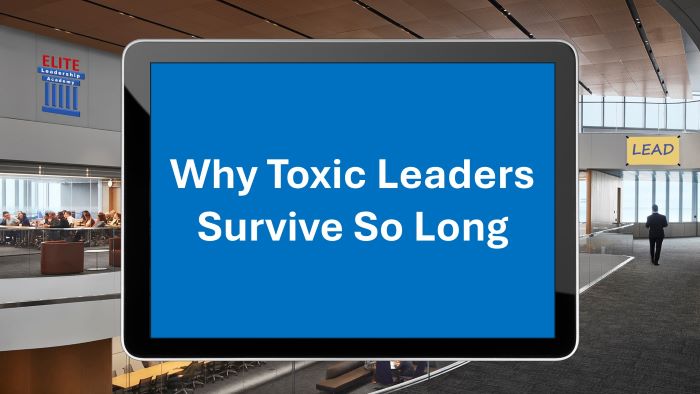Growth in many companies rarely stalls because of a lack of ideas or effort. It stalls because leadership is misaligned on priorities, roles, and ways of working. Small gaps at the top become major disconnects by the time they reach frontline teams, showing up as slow decisions, rework, and competing initiatives.
Continue reading “Reducing Costly Leadership Misalignment”Why Toxic Leaders Survive So Long
People frequently ask why toxic leaders survive in an organization. In this video, I explain some of the reasons.
Continue reading “Why Toxic Leaders Survive So Long”Toxic Leaders: The Silent Profit Leak in Organizations
In organizations, a single toxic leader can quietly drain far more value than a weak product line or a small market loss. Toxic leaders create fear, favoritism, and instability that erode morale, collaboration, and trust. Employees under these leaders report higher stress, lower satisfaction, and a greater intent to leave, which pushes your best people toward competitors who offer healthier environments.
Continue reading “Toxic Leaders: The Silent Profit Leak in Organizations”The 4 Seasons of Building a Winning Leadership Management Culture
If you’ve ever followed a sports team, you know their success isn’t accidental. Coaches and players think in seasons—each with a distinct purpose, each building toward a championship. There’s the preseason, where talent is evaluated. The regular season, where strategy and alignment determine success. The postseason, when only the highest performers rise. And finally, the offseason, when reflection fuels improvement.
Continue reading “The 4 Seasons of Building a Winning Leadership Management Culture”The Leadership Alignment Prescription
TALES FROM THE LEADERSHIP FRONT
Sofia had been the Chief Operating Officer at a west coast hospital system for just six months when she noticed a troubling pattern: department performance varied wildly, and leaders seemed overwhelmed, misplaced, or simply mismatched for the challenges they faced. Nursing supervisors with strong clinical skills were buried in administrative tasks. Tech-savvy managers were stuck in departments resistant to digital change. And rising leaders with incredible people skills were stuck behind data dashboards instead of leading teams.
Aligning for the Future: How One Biotech Leader Transformed His Organization
TALES FROM THE LEADERSHIP FRONT
Daniel Ruiz had spent twenty years climbing the ranks of the biotech industry, but nothing prepared him for the leadership fractures he discovered when he stepped in as CEO of Genexra Labs. Projects stalled, teams second-guessed direction, and turnover quietly bled talent from critical departments. The company’s science was cutting-edge—its leadership alignment was not.
Transforming Nursing Leadership Utilization With LeadershipRM™ – A Case Study Brief
Overview
“Gott Health” (name changed for confidentiality), a fast-growing regional hospital system, faced a leadership challenge. With 20 facilities and over 5,000 nursing staff, the Chief Nursing Officer (CNO) was overwhelmed—managing 24 direct reports, well beyond the limit for effective leadership. Even after reducing the number to 13, she knew a more strategic solution was needed.
Continue reading “Transforming Nursing Leadership Utilization With LeadershipRM™ – A Case Study Brief”3 Costly Leadership Management Pain Points Requiring Immediate Attention
U.S. companies pour over $200 billion into leadership development each year—yet only 10% see real results, according to Harvard Business Review. There are numerous reasons why, but a contributing factor is probably because most organizations focus on developing leaders… but not managing them for sustainable growth.
Continue reading “3 Costly Leadership Management Pain Points Requiring Immediate Attention”The Science of Retention: A Biotech CEO’s Leadership Management Blueprint
TALES FROM THE LEADERSHIP FRONT
As CEO of a fast-rising biotech company focused on personalized medicine, Dr. Aria Fields knew the future of the company rested not just in innovation – but in people.
SHRM25 is Happening Next Week
The SHRM (Society for Human Resource Management) national conference is the world’s largest gathering of human resource professionals with 375 sessions and expected onsite and online attendance of 26,000 people. It will take place at the San Diego Convention Center, June 29th to July 2nd. Learn more about the conference at: https://annual.shrm.org/.
Continue reading “SHRM25 is Happening Next Week”











